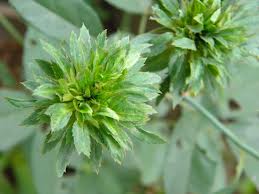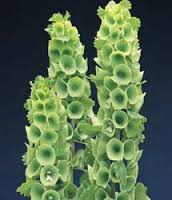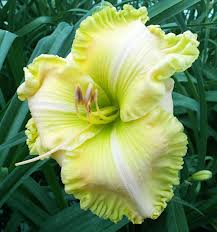Green flowers exert a certain fascination. Perhaps it is because they are rather rare in nature. The purpose of colorful flowers is to attract pollinators to insure the genetic continuation of the plant. Green flowers are not going to stand out against the green foliage and so are not going to gain much attention from bees and butterflies. Gardeners, however, may be more perceptive than insects.
My fascination with green flowers began many years ago at Hershey Rose Garden. They had growing there a true green rose. It was the first one I had ever seen and as roses go it wasn’t particularly attractive. The rose was Rosa chinensis var. viridiflora. This rose has no true petals. What appear to be petals are layers of sepals, which are the green part of a flower that forms the calyx from which the petals appear to emerge. The sepals make up the entire flower so the plant is sterile. Gardeners have been propagating it, since its appearance in 1743, from cuttings. It was almost 100 years before commercial growers became interested in this rose. It may have been marketed in the past but it is difficult to find today. The only place that it appears to be available is at the Antique Rose Emporium (http://www.antiqueroseemporium.com/roses/201/green-rose). Should you be so lucky as to acquire one the green rose is cultivated like any other rose and requires little space reaching a height of only two feet. It is hardy to zone 10 in the south and zone 5 or 6 is its northern range.
There are lots of other green flowers out there, although some of them are not so green. A true green annual is Bells of Ireland. (Moluccella laevis) Again it is
not the flower that is actually green. The white flower is inconspicuous but the green calyx is very showy. The plant reaches a height of 36 -48inches but there are smaller varieties such as ‘Pixie Bells’ from Burpee. Seeds may be started indoors or sown in early spring. Bells of Ireland require full to part sun.
Green Envy zinnia (Zinnia elegans ‘Green Envy’) is another true green flower. Its flowers are a bit smaller than normal zinnias and the plant reaches 3-31/2 feet. The seeds can be direct sown 6-8 weeks before the last frost or started indoors. Getting them out as soon as possible is advisable as they are said to be prone to late summer powdery mildew. ‘Green Envy’ is actually an heirloom plant so the seeds may be saved from year to year. Seeds for ‘Green Envy’ are readily available anywhere seeds are sold.
A 2009 hybrid petunia is not actually green but is peculiar in that it is a bright pink with a green border. It is registered as Supertunia® Pretty Much Picasso™. It grows to 24 inches across and is suitable for baskets pots and as a bedding plant. It is said to flower weeks longer than regular petunias but should be cut back by about a third in July to rejuvenate the plant.
“Green” perennial flowers tend to be less green than green annuals. Among tulips we have ‘Spring Green’, which blooms in late spring. It is a white tulip with green feathering. It won the 1993 Award of Garden Merit and is available at Brecks. Others are ‘Groenland’ and ‘Green Village’, which are pink with green markings.
There are several green coneflowers but the colors are subject to opinion. Echinacea purpurea ‘Coconut Lime’ has a green/yellow or chartreuse center. The petals, which are not particularly conspicuous, are white. It seems to be a reasonably strong grower but is sterile and cannot be grown from seed. The ‘Green Envy’ coneflower has a poor reputation. The plant is a prolific seeder and must be deadheaded or will reseed all over the garden. The flowers are unique in that the inner part of the petal is pink and the outer edges are green. A number of growers report that the petals rapidly change to all pink or that the green border is not very prominent.
Phlox paniculata ‘Jade’ is another flower with white petals edged in celadon green. This plant was introduced in 2009. It bears large panicles of flowers and are ideal for cutting as they hold their petals until all of the individual flower in the panicle have bloomed. The plant is 18-20 inches in height with a spread of 24 inches. It is said to be “somewhat” mildew resistant. ‘Mystic Green’ phlox has white flowers with a shiny red center and contrasting green edges. This one is 22 inches and mildew resistant. Both are fully hardy and easy to find.
Green daylilies are at best ‘sort of green’. ‘Green Abyss’ is a tetraploid, 30 inch, early to midseason bloomer that is described as “large near green daylily with a
matching green edge”. This daylily is priced at $300 dollars as the green color breeds true and it is the darling of hybridizers. The pictures look yellow to me. On a more practical note ‘Key Lime Ice’ is a “Green-cream blend with a braided gold edge”. “Green Mystique” is a “cream blend with a green wash above a green throat.” Neither of these appears to be very green except for the throat of ‘Green Mystique’.
Why grow green flowers? Well, they are a great conversation piece and the truly green ones are quite startling when the eye connects with them and recognizes them as a flower. The shades of green are often quite interesting when contrasted with the green of the foliage. Green flowers really come into their own as cut flowers in arrangements where they stand out among the more colorful blooms.. So, why not go green this summer?


